Reminder: Due to logistic challenges in the Izza Pziza dairy, beginning this week, orders for their goat milk products will close earlier than regular Chubeza orders (for Wednesday deliveries.) Henceforth, orders for goat milk products may be placed until Sunday, 10:00 pm. After this time, no changes or cancellation to your Izza Pziza order can be made.
If you wish to order milk products on a permanent basis, we suggest adding them to your fixed order. As such, you will not be limited by the change in closing time.
Check out the price list for additional products (milk products included).
Thanks for your cooperation!
____________________________________
One of the very first vegetables to accompany the undependable Spring weather is the very dependable squash. You have already noticed him in your boxes, and you’re sure to see a lot more in the near future: the light Galilean squash and dark green zucchini as well as the yellow and striped zucchini. As the leader of the band, we happily dedicate our exuberant late-Spring Newsletter to this remarkable vegetable.
Squash belong to quite a prominent family – the Cucurbitaceae’s, a very diverse, widespread clan whose members are grown primarily for food, but also for other interesting uses. Within the subdivision of cultivated plants, the family tree splits off into five main branches: the cucumber, fakus and melon; watermelon; various types of pumpkins and squashes; the decorative, inedible pumpkin that is used for decorations and to make serving utensils and musical instruments; and the Lupa pumpkins, whose skin is used to prepare natural sponges.
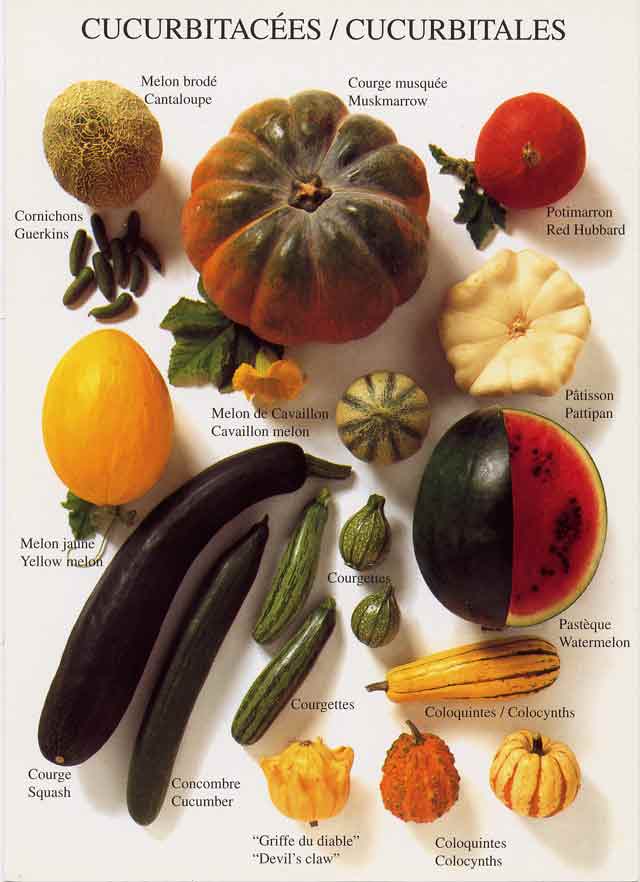
As mentioned, pumpkins and squash are close cousins, except that the pumpkins are harvested at maturity after a long growth period of 3-5 months, when their shell is hard and the seeds within are stiff and plump. Conversely, squash are harvested young, after only one or two months of growth. Their rind is still soft, and chafes easily. Their seeds are thin and barely discernable, which is why there’s no need to remove them before eating.
Squash and pumpkins are natives of Central America. Columbus introduced them to the Europeans, who first grew them only in botanical gardens, enjoying their beautiful blossoms. The Israelites, pleading “We remember the fish we ate in Egypt at no cost–also the squash, melons, leeks, onions and garlic…” apparently were not craving what we call squash, but probably the fakus, their African/Mid-Eastern cousin.
Even within its very own family, squash vary from one sibling to another. The Mid-Eastern squash is chubby and light green. His longer and thinner brothers the zucchinis received their name from the Italian zucca for pumpkin, thus “a small pumpkin.” Chubeza grows dark green, yellow and striped zucchini. And there are also round squash varieties used to stuff, and even beautiful flower-shaped squash.
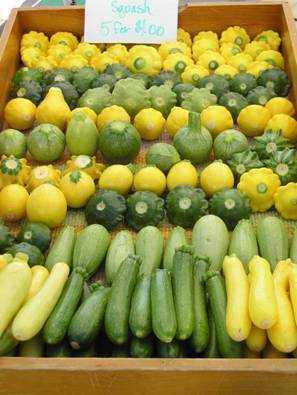
Squash season starts here at the end of winter. We sow our squash seeds in the beginning of February when it’s still mighty cold. In order to protect them, we cover the earth with a plastic surface, and cover the seeds with another plastic cover to insulate them from the cold. The result is a sort of tunnel that heats up from the sunrays and acts as a shield from the biting frost and any end-of-winter storms. Usually in the first rounds, we use transplants as well as seeds. In the annals of Chubeza, there were years when our first squash crops suffered a mysterious disappearance due to the young sprouts being eaten, probably by crickets or other earthy inhabitants. This was another reason to choose transplants during this season, attempting to outwit the pests.
And why do they need protection from insects? These aren’t your average vegetarian insects who need to feast on some squash greens, but rather flies, mosquitos and other fly-by insects who merely wish to land a hand or leg on the squash. The problem is that they aren’t great about handwashing, and therefore transmit viruses and diseases that damage the little squash plants. The viruses and leaf diseases are the worse problems this gourd family encounters, and the squash, fakus, melons and various little pumpkins are most sensitive of all. Which is why we cover them with cloth as they start their lives in the world, just like we would put up a screen at home to prevent flying insects from entering our living space. Once the squash begins to bloom, we remove the cover, because it’s a whole new concert now, and for this segment we do need the humming of flying insects…
So how does squash move from being a green, impressive plant to actually ripening and bearing fruit? Along the way, there are the big and beautiful yellow flowers, lovely to look at and particularly attractive to yellow-loving pests. The squash plant bears flowers of two types: male and female (everything written about squash holds true for pumpkins, cucumbers, melons, watermelons, fakus and the rest of the Cucurbita or gourd family). The flowers resemble each other from afar, but when you look closely, the differences are evident.
This is what the male flower looks like: 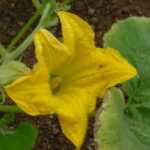
and here it is close up: 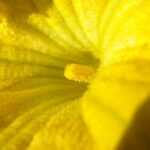
And this is what his female counterpart looks like: 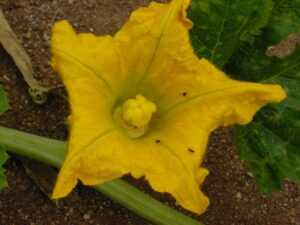
Close up: 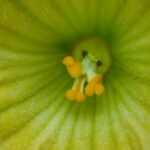
The insects are thrilled by the bright yellow, and they enter the male flower, have their fun, and gather some nectar and pollen that look like this:
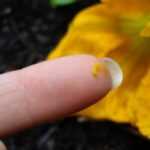
Then they continue on to frolic in the next nearby playground, the female flower, spreading the male pollen all over. The now-fertilized female flower closes and shrinks, and at the end of the process looks like this:
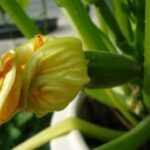
If you look closely, you will see that at the edge of this flower, a fresh, new little squash is growing. It’ll only take him a few days before he is ready for careful and delicate picking, so as not to scratch or damage the shiny, delicate peel. Squash grow so quickly that we harvest them daily. A squash forgotten on the bush will be discovered a few days later in monster-like dimensions…
Squash is low in calories and high in dietary fibers. It contains magnesium, potassium and folic acid, Vitamins A and C and other antioxidants. Zucchini has a fresh, neutral flavor (some will call it bland), but no need for a PR campaign: its neutral taste is probably the ingredient that made zucchini a favorite child in almost every country. In France they are used in ratatouille and quiches; in Italy they are prize components of caponata, frittata, antipasti and pasta primavera. The Italians also harbor a special affection for stir-fried zucchini flowers. Romania and Bulgaria cook it in a givetch, in Turkey it stars in patties, in the Middle East one can stuff it with rice and chopped meat, and Iraqis use squash generously in kubeh soup or sauce. In the Far East, zucchini and squash are stir-fried together in a wok, while in the United States they make their way into to yummy bread and zucchini jam……
But hey, zucchini can also be eaten with no cooking whatsoever, nor frying or baking – Just squeeze them to make squash juice, a great detox for the body. At Chubeza, when a cucumber shortage struck, we used to happily chop zucchini to fill our family lunch salad, and then scrape the bowl clean.
Wishing you all a calm and wonderful week, All of us at Chubeza
______________________________
WHAT’S IN THIS WEEK’S BOXES?
Monday: Fakkus, butternut squash, lettuce, cucumbers, beets, tomatoes, potatoes, New Zealand spinach, zucchini, corn, parsley.
Large box, in addition: Swiss chard/kale, melon/onions, eggplant/leeks/garlic.
FRUIT BOXES: Peaches, plums, nectarines. Small boxes: bananas Large boxes: apples
Wednesday: Fakkus, acorn squash, lettuce/Swiss chard, cucumbers, beets, tomatoes, potatoes, New Zealand spinach, zucchini, leeks/garlic, parsley.
Large box, in addition: Corn, eggplant/green beans/onions, butternut squash/Napoli pumpkin.
FRUIT BOXES: Peaches, nectarines, bananas. Small boxes: apples. Large boxes: cherries.
